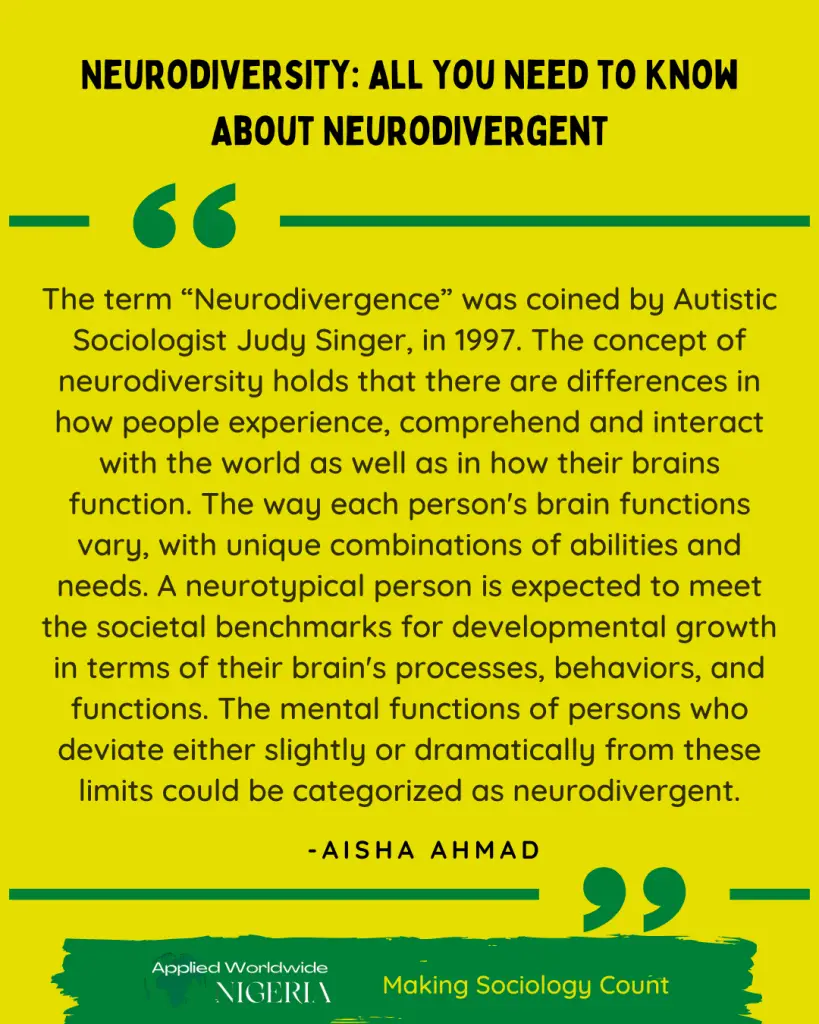What do Albert Einstein, Sir Isaac Newton, Nicola Tesla, and Charles Darwin all have in common? The obvious answer would be they’re famous for being great inventors/theorists. But what if I told you they were all neurodivergent?

What is Being Neurodivergent?
The term “Neurodivergence” was coined by Autistic Sociologist Judy Singer, in 1997. The concept of neurodiversity holds that there are differences in how people experience, comprehend and interact with the world as well as in how their brains function. The way each person’s brain functions vary, with unique combinations of abilities and needs. A neurotypical person is expected to meet the societal benchmarks for developmental growth in terms of their brain’s processes, behaviors, and functions. The mental functions of persons who deviate either slightly or dramatically from these limits could be categorized as neurodivergent.
Neurodivergent is a non-medical umbrella term that defines persons with variations in their mental functioning. It might encompass conditions like autism spectrum disorder (ASD) or other neurological or developmental disorders like attention-deficit hyperactivity disorder (ADHD).
They usually have variances in their cognitive abilities, learning preferences, sensory processing, interpersonal interactions, and behavioral patterns. Soft skills like social interaction, emotional intelligence, and the capacity to function well in a group may be difficult for them to develop. There could also be other physical behaviors such as close physical contact, speaking loudly, or self-soothing gestures like rocking or twitchy hand movements.
Types of Neurodiversity
The conditions or disorders typically found in neurodivergent individuals are Autism spectrum disorder (ASD):
Autism is a developmental impairment brought on by variations in the brain. People with this spectrum may struggle with social communication, interaction, and restricted or repetitive behaviors or interests. Which may lead them only to communicate non-verbally. Statistically, one out of every 160 children lives with this condition and there are 135 million cases worldwide. Autistic children usually have great attention to detail, intense concentration, creativity, and visual learning abilities.
Attention-deficit hyperactivity disorder (ADHD)
ADHD is one of the most common neurological disorders. It starts from early childhood into adulthood. People with ADHD can often seem restless, and impulsive, and have trouble concentrating and handling strong emotions. Sleep and anxiety disorders are other problems associated with this spectrum. Due to their unconventional thinking, people with ADHD are usually great problem-solvers, fun and energetic, and more sensitive to others.
Down syndrome
People with this disorder are born with an extra chromosome, which affects how their body and brain develop as they age and may cause mental and physical difficulties. Low muscle tone, small stature, upward-slanted eyes, and a single deep crease across the middle of the palm are all physical characteristics of Down syndrome.
Dyslexia
This is a learning disorder that makes it difficult to read due to problems recognizing vocal sounds and understanding how they relate to letters and words. Dyslexia often referred to as a reading disability, is brought on by individual variations in language processing areas of the brain. People with dyslexia frequently have a broad perspective and excellent visual processing skills. They also frequently exhibit high spatial awareness and may be exceptionally creative.
Dyspraxia
Dyspraxia, also called developmental coordination disorder (DCD), affects a person’s ability to move, coordinate, make decisions, process information, remember things, and other cognitive skills. It is three times more common in boys than girls. Children with DCD may experience delayed early developmental milestones of crawling, walking, self-feeding, and dressing.
Dysgraphia
This is a neurological condition that affects a person’s ability to turn thoughts into written expressions, and their fine motor skills, despite exposure to adequate education and instruction. It is an impairment in written expressions. Different ages and stages of dysgraphia can cause a variety of symptoms. Children with dysgraphia often exhibit difficulty in spacing things on paper, poor spelling, and cramped hand grips which lead to sore hands. Adults may develop dysgraphia after a brain or head trauma.
Other types of neurodiversity include but are not limited to; dyscalculia, social anxiety, sensory processing disorders, and mental health conditions like bipolar disorder and obsessive-compulsive disorder.
How to Know If You’re Neurodivergent
If you have been diagnosed with any of the disorders above, you would be regarded as neurodivergent. On the other hand, if you have never received an official diagnosis but strongly identify with one or more neurodivergence characteristics, you might find it
beneficial to consult a professional. If you have never received an official diagnosis or experienced any of the above symptoms, you most probably fall under the neurotypical category.
Although neurodivergence is common, many people do not become aware of it until they are adults. This can present hurdles as individuals try to adapt to the variations in their thought and how they process information, but it can also be advantageous. When people learn they have ADHD, autism, or another type of neurodivergence, it often helps them to comprehend aspects of themselves that they had previously found difficult to explain.
Can Neurodivergence be Treated?
Because neurodiversity refers to the unique way each person’s brain is structured and works, it can neither be treated nor cured. However, the conditions that cause a person to be neurodivergent can be managed. Early detection is key to achieving this. There is a wide range of management options, therapy programs, and more.
Medication and behavioral treatment can enhance the quality of life for people with developmental disorders, such as those with ADHD. Others may benefit from therapeutic programs that teach them how to “play to their strengths,” or how to maximize their skills. They can also teach you how to deal with difficulties so that they have less of an impact on your life.
Tips on Care for Neurodivergent Children
Caring for neurodivergent children requires intentionality, research, and high bouts of emotional intelligence. They are not like neurotypical children that have a standard care/upbringing routine. Because their brains function differently from what is typical, you have to understand and tailor your care to their needs and requirements. The following are tips on caring for them:
- Support them at home
- Have a routine set
- Positive reinforcement and reward system
- Avoid value-based labels
- Find a community/support system
- As a parent/guardian, self-care is equally important
Famous Neurodivergent
Did you know that Thomas Jefferson was Autistic? Ingvar Kamprad, the man who founded IKEA, had ADHD and was dyslexic. Albert Einstein and Henry Ford also struggled with dyslexia. Richard Branson, the founder of Virgin Atlantic Airlines, struggled with not one but two neurological disorders; ADHD and dyslexia. Bill Gates has dyslexia, he struggled in school and eventually dropped out but still founded one of the biggest tech companies in the world, Microsoft. Emma Watson was receiving medication for ADHD while on set for the Harry Potter franchise. Charles Darwin, Sir Isaac Newton, Steve Jobs, Nicola Tesla, and Michelangelo were also neurodivergent.
I believe neurodiversity is the secret ingredient for great innovations. Personally, I think of them as “superheroes.” The world needs a neurodiverse workforce to solve some of its biggest problems.
Stress In Nigerian Universities: Simple Ways to Cope With Stress in School





